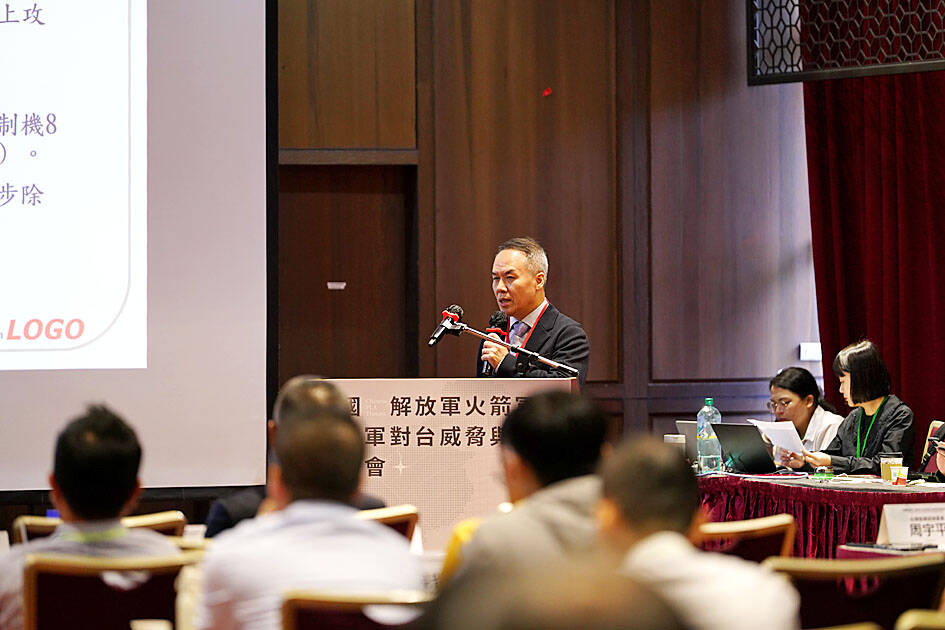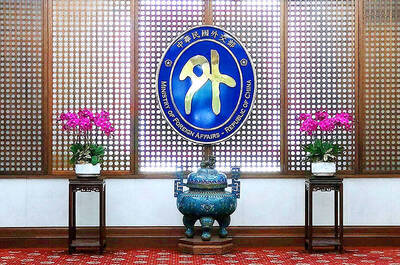Taiwan should continue upgrading and expanding its anti-air defense capabilities to counter and deter China’s military force, Taiwan Thinktank consultant Kao Chih-jung (高志榮) said on Tuesday.
Speaking at a seminar hosted by the think tank, Kao said the Chinese People’s Liberation Army’s Rocket Force (PLARF) has six combat missile bases (bases 61 to 66), with each hosting six to eight missile brigades, and three support bases (bases 67 to 69) that host a total of 47 brigade-level units.
Equipped with short, medium and long-range ballistic missiles as well as land cruise missiles, the PLARF is tasked with launching missile strikes against airfields, bunkers, jets or ships of the US or its allies operating in the Indo-Pacific region, he said.

Photo: Aaron Tu, Taipei Times
Kao estimated that the PLARF has more than 400 intercontinental ballistic missiles and about 2,700 other types of ballistic missiles.
About one-third, or 900, of the Chinese arsenal are short-range ballistic missiles, such as the Dong Feng (DF)-11, DF-15 and DF-16, that are aimed at Taiwan, he said, adding that most of them are housed in bases 61 and 63, under the command of six short-term ballistic missile brigades.
While short-range ballistic missiles form the brunt of the Chinese missile arsenal against Taiwan, other types can also be used when needed, Kao said.
Commenting on the Chinese capability to strike Taiwanese air bases, Kao said that for the PLARF to completely paralyze Taiwan’s capabilities to launch aircraft, it would need to sever the two main runways at Taiwan’s military airfields into sections that are less than 3,000ft (914m).
To accomplish this, the PLARF would need to launch about 500 ballistic missiles, and a supplement of 1,080 PHL-191 rockets, attack Hsinchu Air Base, Taichung’s Ching Chuan Kang (清泉崗) Air Base, Chiayi Air Base, Tainan Air Base and Penghu Air Base, Kao said.
Moreover, China would need to fire 288 ballistic missiles within two hours to overwhelm Taiwan’s air defense systems, he said, adding that China could employ long-range rocket strikes against outlying military garrisons, such as Dongyin Island (東引).
Taiwan has 21 sets of long-range anti-air systems, and if China wants to fully overload Taiwan’s air defenses, it would have to launch additional CJ-10 cruise missiles, as well as send its planes to fire long-range missiles, he said.
In total, China would need to launch more than 800 ballistic missiles against Taiwan in the first wave, he said.
Failing that, China would need to launch a second barrage within half an hour to continue the attack, he said.
Such an attack would severely strain the PLARF’s reserves, Kao said.
Taiwan should continue to upgrade its extended-range Hsiung Feng II-E and Tien Kung missiles, he said, suggesting that the government continue purchasing newer versions of the Patriot-III missiles to deter the Chinese from bombarding Taiwan into submission.
Citing public information, Kao said that Taiwan’s HF-IIE missiles are based in Taoyuan’s Yangmei (楊梅), Lujhu (蘆竹) and Taishan (泰山) districts, as well as New Taipei City’s Sansia District (三峽), suggesting that the Chinese might target these four districts.

The Ministry of Foreign Affairs (MOFA) yesterday voiced dissatisfaction with the Comprehensive and Progressive Agreement for Trans- Pacific Partnership (CPTPP), whose latest meeting, concluded earlier the same day, appeared not to address the country’s application. In a statement, MOFA said the CPTPP commission had "once again failed to fairly process Taiwan’s application," attributing the inaction to the bloc’s "succumbing to political pressure," without elaborating. Taiwan submitted its CPTPP application under the name "Separate Customs Territory of Taiwan, Penghu, Kinmen and Matsu" on Sept. 22, 2021 -- less than a week after China

THE GOOD WORD: More than 100 colleges on both sides of the Pacific will work together to bring students to Taiwan so they can learn Mandarin where it is spoken A total of 102 universities from Taiwan and the US are collaborating in a push to promote Taiwan as the first-choice place to learn Mandarin, with seven Mandarin learning centers stood up in the US to train and support teachers, the Foundation for International Cooperation in Higher Education of Taiwan (FICHET) said. At the annual convention of the American Council on the Teaching of Foreign Languages held over the weekend in New Orleans, Louisiana, a Taiwan Pavilion was jointly run by 17 representative teams from the FICHET, the Overseas Community Affairs Council, the Steering Committee for the Test of Proficiency-Huayu, the

A home-style restaurant opened by a Taiwanese woman in Quezon City in Metro Manila has been featured in the first-ever Michelin Guide honoring exceptional restaurants in the Philippines. The restaurant, Fong Wei Wu (豐味屋), was one of 74 eateries to receive a “Michelin Selected” honor in the guide, while one restaurant received two Michelin stars, eight received one star and 25 were awarded a “Bib Gourmand.” The guide, which was limited to restaurants in Metro Manila and Cebu, was published on Oct. 30. In an interview, Feng Wei Wu’s owner and chef, Linda, said that as a restaurateur in her 60s, receiving an

MORE RETALIATION: China would adopt a long-term pressure strategy to prevent other countries or future prime ministers following in Sanae Takaichi’s steps, an academic said Taiwan should maintain communications with Japan, as Japanese Prime Minister Sanae Takaichi is to lead a revision of security documents, Taiwanese academics said yesterday. Tensions have risen between Japan and China over remarks by Takaichi earlier this month that the use of force against Taiwan would constitute a “survival-threatening situation” for Japan. Prospect Foundation president Lai I-chung (賴怡忠) yesterday said Takaichi’s stance regarding Taiwan is the same as past Japanese prime ministers, but her position is clearer than that of her predecessors Fumio Kishida and Shigeru Ishiba. Although Japan views a “Taiwan contingency” as a “survival-threatening situation,” which would allow its military to